#biomimcry
Explore tagged Tumblr posts
Text

Skin and bones
#architecture#denver#colorado#mad#architects#mayansong#biomimcry#design#natural landscape#glass building#contrast#organic#machine
1 note
·
View note
Text
Design - Taking the Nature Route
Nature has been evolving refined mechanisms to survive gracefully on Earth. Organisms have perfected these systems to meet their needs through natural selection and species competition. Natural systems have been “designed” in a way that they follow the concept of recycle, decompose, and purify. Concepts which help us in understanding biology in interiors are briefly explained.
Introduction to Bio mimicry and Eco-Design
Eco Design also known as earth-friendly, is an approach of designing with special consideration about the environmental impact by its use. It contributes to green-living and prevents damage of natural resources, helping us in controlling the pollution which the world has been facing these days. Similar to the above concept is Bio mimicry, which is an applied science that derives inspiration for solutions to human problems through the study of natural designs, processes and systems. It is the way to innovation and sustainability and interior architecture must move beyond the characteristics of nature. Different people from various backgrounds nowadays are taking cues from organisms in nature and applying those concepts to new technology that is conducive to life
Preserving natural resources
Examples of bio-mimicry are increasing in popularity as we are realizing the importance of sustainability. The aim is to get inspiration from nature and introduce elements of it in our interiors without harming the natural resources. By keeping the concept in mind, interior designers can help reduce the depletion of natural resources by following a sustainable design which can be done by many ways.
Firstly, energy consumption is one of the major contributors to climate change, to save energy spent on lighting; a lot can be done just by picking the right colours. Lighter colours reflect more light, decreasing dependency on artificial light. Window coverings, blinds and shades enable residents to control the building’s temperature in an energy efficient way by opening and shutting them as needed. For this, choose natural fabrics, such as organic linen or wool, and ensure that wood for shutters and blinds comes from renewable sources.
To prevent materials from getting discarded too often, designers should consider the lifespan of any material they plan to use, especially for those elements that experience a lot of wear and tear like flooring. Therefore materials such as concrete, bamboo, cork and stone are good green options for flooring as they have built-in durability.
A new concept of reusing old materials to produce stylish decor has been trending, known as “up-cycling”. With this you not only give a new life to the object but also enhance the spaces’ spirit and functionality. Using wine barrels to create tables, old suitcases as drawers or centre tables etc. Are few examples.
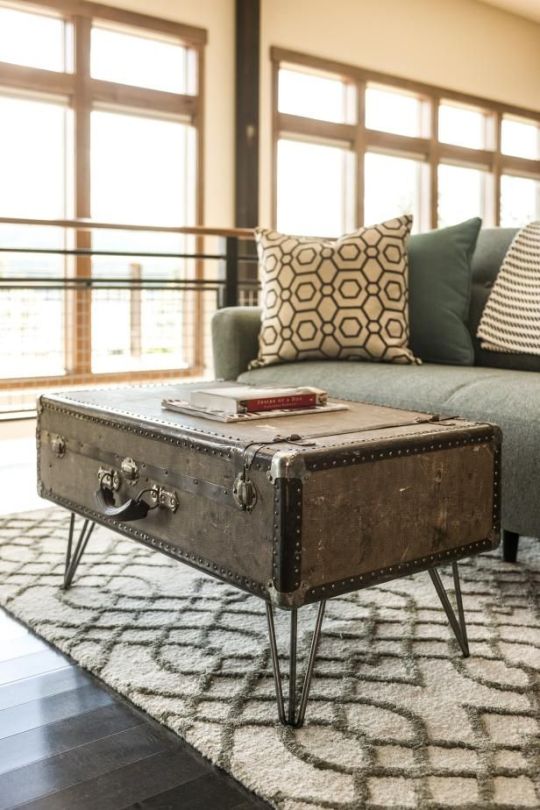


Mimicking nature
Nature is by far the richest source of inspiration and knowledge that we have. Over the decades, the field of bio-mimics has shifted from looking towards nature for its overall shape. Sea creatures, crab shells and spider webs are among the species and natural artifacts.

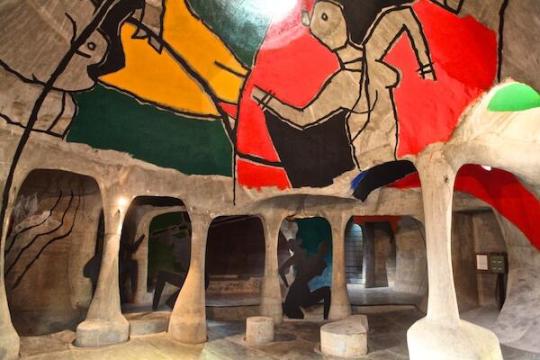
Designers have looked for inspiration. To name a few, tree-like columns, exhibition spaces inspired by rocks and caves, buildings inspired by soap bubbles or even following the patterns on butterfly wings and using them as artifacts show us how we have been inspired by both flora and fauna and incorporated it in our interior surrounding. Velcro was created in 1941, was inspired from burs, prickly seeds that are known to get attached to animals and clothing upon contact.
Student of California State University -led teams from design methodology class, came up with an innovation for the international Biomimicry Challenge. It was called “Phalanx insulation”,a panel system that can be fixed on the exterior of a building, reducing the interior temperatures of buildings without the need for electricity. The three-layered system has been inspired from flora and fauna -cactus, Saharan camels and silver ants. This invention makes use of wasted water, and ultimately helps us bring down the temperature.
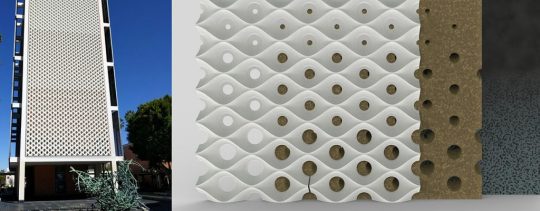
Top Layer was inspired by the cactus’s ability to shade itself. It would also be coated in a translucent gloss to help reflect more light away from the structure
Middle layer was created to resemble the termite’s mound, channeling air upward and able to retain a lot of heat
Bottom layer was inspired by the ability of wheat to move water vertically and release it. The increased surface area allows it to retain more moisture
Architecture has always been inspired from nature elements be its flora or fauna. Some Incredible masterpieces has been derived from nature and made them by their shapes or structure. It does not look only beautiful but with manner of getting natural light, energy or ventilation.
Nature has always helped human race to make it more accurate and understand them with practical things.
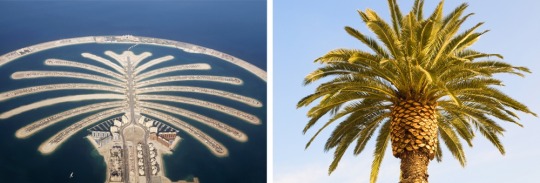
Palm Islands in Dubai
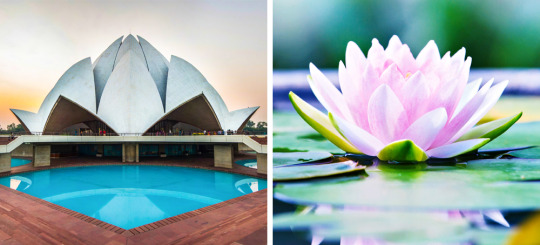
Lotus Temple in New Delhi
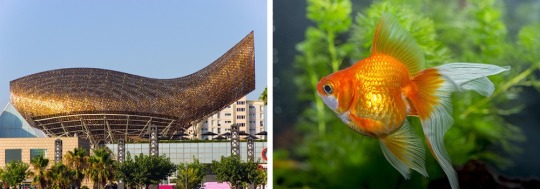
Olympic Pavilion in Barcelona
In order to advance the environmental justice movement, we need to shift how we think about sustainability to include solutions like bio mimicry because it provides countless opportunities for improving our world. Our world’s finite natural resources are depleting, and it is becoming increasingly urgent to find sustainable solutions to global issues.
Compiled by Goldy Chitkara & Sanya Nahar (Team Design Radiance)
Bibliography
· http://web.csulb.edu/sites/beachmag/2018/08/human-nature/
· https://biomimicry.org/launchpad-teams-advance/
· https://medium.com/@ECONYL/5-principles-of-sustainable-interior-design-b390503a5176
#biomimcry#organism#naturalsystems#ecodesign#resources#greenliving#sustainability#innovation#interiordesign#architecture#technology#energy#lighting#materials#upcycling#nature#insulation#flora#fauna#environment
3 notes
·
View notes
Text
New artificial cell successfully minimised to target and kill specific bacteria.
New artificial cell successfully minimised to target and kill specific bacteria. Thoughts health innovators?
An artificial cell is a bioengineered particle which mimics a naturally occuring biological cell. The hypothesis is that the synthetic biologic biomimics some of the properties of cells, such as surface characteristics, shapes, morphology, or a few specific functions. Therefore artificial cells have a multitude of applications in many fields from medicine to environmental science. However, even…
View On WordPress
#artificial#bacteria#biology#biomimcry#biomimetic#cell#ecoli#health#healthinnovations#immune#immunology#science#superbug#synthetic#system
5 notes
·
View notes
Text
which fantasy races do I want?
fantasy races based on bacteria, with lots of symbiotic teamups and casual gene-swapping across species. fantasy races based on underwater ecosystems and other extreme habitats (land versions of coral reefs! magical zones of extreme pressure / lighting conditions that favor races like deep-sea creatures! etc.). fantasy races based on Ice Age species like those being excavated from La Brea tar pits! fantasy races set on worlds like Mars or Pluto with adaptations to match
212 notes
·
View notes
Text


September 1- day 19
Today I:
Started a permaculture course!
Did some field measurements
Looked into new programs
Learned Arc GIS basics
Went for a walk
Happy September everyone!!! I hope this month brings you joy and lots of opportunities for growth! (Pic left: my study space featuring Introduction to Permaculture by Bill Mollison, my notes reminding me to read books related to sustainable architecture and Biomimcry + my highlights. Right: Mexican plum plant found at my local park.)
Listening to: Exodus! by John Powell
Reading: Biomimicy by Jane Benyus + Gulp by Mary Roach
#trying my best#studyspo#student#100 days of productivity#100 days of self discipline#study motivation#100 days of positivity#academia#university#books#study with me#study space#studyinspo#motivation#100 dop#light academia#dark academia#romantic academia#cottagecore#bookblr#studyblr#study blog#reading#book recommendations#library#bookstore#geography
8 notes
·
View notes
Photo


Another example of Biomimicry.
French studio XTU Architects developed a glass tower concept for a site in Hangzhou, China that fuses design and innovative technology. The structures are not only intended to beautifully twist from the base upward but they also incorporate a patent-pending insulation technology that involves micro-algae.
0 notes
Text
Biomimicry
I recently viewed a video on biomimicry: In summary, biomimicry is the practice of designing human innovation after aspects of nature. The underlying principle behind this process is nature’s efficiency. Any part of the natural world, from a tree leaf to a bird’s beak, has spent billions of years evolving to suit its environment in…
View On WordPress
1 note
·
View note
Text
New artificial photosynthesis process converts CO2 in air to fuel | KurzweilAI
New artificial photosynthesis process converts CO2 in air to fuel #biomimcry
http://www.kurzweilai.net/new-artificial-photosynthesis-process-converts-co2-in-air-to-fuel
0 notes
Text

Fashion for Conservation and Hoja Nueva Artesanía Project
Fashion for Conservation (FFC) is an organization that works in the Peruvian Amazon and uses fashion as a way to help empower the women of the Las Piedras region. Many of the native communities in this part of the Amazon have the ability create locally made artisan crafts (such as jewelry and bags), but they lack the tools needed to get their products to market and generate reliable streams of income for their family and communities. Through its artisania project, FFC is trying to help provide these resources by bringing materials and technology to native communities and helping connect then to markets both inside and outside of Peru. During my time here, I am talking to each of the communities FFC serves to better understand: A) their cultural connection to the natural environment, B) the role the natural environment plays in their approach to design and problem solving, C) their most immediate needs and desires with the artisania program. After conducting the interviews, my site supervisor and I will collaborate on what solutions FCC can help develop in the next month. We are considering solutions such as growing gardens that provide communities with seeds and plants needed to make dyes and beads; creating marketing materials for each community to provide to local stores that may want to sell their crafts; and facilitating workshops hosted by one of the regions’ most thriving native communities. For the research component of my project, I’m trying to understand how the natural environment may inspire design and development solutions in native communities. Perhaps using the environment as inspiration for sustainable development solutions, similar to the way designers from developed countries employ biomimcry, could help preserve traditional ecological knowledge. My first community visit and my time in the jungle have made me realize how often there are much more pressing issues than environmental change (potable water, economic prosperity)— and yet how rarely those issues have to be considered separately. The biggest challenge I’ve faced so far has been communicating in Spanish, but my skills are slowly getting better the longer I’m here ;)

l’ll leave you with a question similar to one I’m asking in my interviews here:
Can you think of any specific products, processes, or systems in our society that have been or could be improved through inspiration from nature?
3 notes
·
View notes
Text
Sabine Lettmann
We where able to listen to Sabine Lettmann’s lecture on sustainability as a whole across fashion yet also within her own brand and what she is trying to accomplish.
Most fashion businesses currently use a linear economy which follows the Take-Make-Waste principal and has major implications on the people and the planet. There is still a way for clothing to be made more sustainably, such as using better materials with less of an environmental impact, producing less or adopting zero waste techniques or using more environmentally friendly materials.
One big impact we have on the planet is that 75% of our discarding clothing eventually ends up in landfill some without having been worn and only 1% of clothing is recycled. The chemicals used to dye fabrics can often change the colour of waters in rivers with the colours of next season’s trends. Toxic chemicals can also impact the lives with pollution and health hazards. And still to this day companies do not have safe working environments for their workers.
The planet’s resources are dwindling, each we cultivate more and more of the resources than can be replenished and leave more and more waste than the Earth can handle. As well as other resources we use these finite resources to develop millions of garments, produce and distribute them. Earth Overshoot Day is the point at which we have already used the annual budget yet this gets earlier in year as we move forward. In 2019, the UK reached this point on the 17th of May.

This is the predicted date for this year.

It is if we haven’t learnt from our past that resource availability is getting smaller the more we try and produce. Theoretically we would need more than one planet to sustain our demand, as stated below, unfortunately we don’t. We gained dept that we are unable to pay back.

Collaboration is key to drive change and as someone creative entering this field along with many others we can come together and hopefully look for new solutions to this problem. We need to individually change our own mindsets towards the fashion industry as it is and try to make it more sustainable yet it needs to be more common knowledge by being a part of initiatives such as Fridays for the future or Plant for the planet to challenge the old-fashioned mindsets which will allow for faster change.
Significant change can be made in each part of the supply chain such as:
Responsible sourcing - Recycled materials
Responsible waste management - Re-using fabrics to avoid leftovers and financial loss as creating new designs using existing material
Responsible design - Zero waste designs, the aim is to find a balance between shapes and fit as well as aesthetic appeal without material waste
Responsible production - Instead of creating physical samples use digital simulations like 3D which will reduce waste and costs also improving communications between production companies
Responsible sales - Lease or renting clothes instead of buying them, companies like Swedish brand FilippaK who work with additional in-house leasing systems.
Responsible consumption - Consumers influence fashion’s problem with waste by extending the life of a garment which can lead to a 5-10% decrease in carbon, water and waste if extend by at least 3 months.
This will all help but to become a more sustainable industry we need to move away from the linear economy and replace it with a circular or closed loop economy.
A circular economy drives to design out waste, keep products and materials in use and regenerate natural systems. This follows the idea that products can be returned to their biological or technical state at the highest value possible. There are 6 strategies on which is based circular design. This involves, Smart material choices, modularity, product life extension, product as a service, closed loop/take back and embedding intelligence. Smart materials include Biomimcry which looks at programable knitting like process of a pinecone in which it respond with its surroundings reacting to humidity or dryness will potential in sportswear.
As a designer Sabine has always focused on sustainability with collections based on:
good materials
small quantities
local production
integration of social institutions and workshops
“At some point that wasn‘t enough for me. Therefore, I created a circular unisex collection concept as an open source for other brands and designers called ‘Otherways Project’” - Sabine Lettmann
0 notes
Text
Biophillia
Humans like little habitats
Dopamine released
Walks with pets and nature have healing powers
Since 1850 it’s been believed that nature has healing powers, “…believed that the beautiful setting…restored patients to a more natural balance of the senses”
How might I employ this concept into my own research?
These examples of biomimicry provide proof that humans can learn many useful things if we were to direct our studies on our environment. Through living harmonically with nature we can truly achieve a higher level of living. To employ this kind of thinking into my own practices I might create some visual representations influenced by natural patterns to attack certain issues. It is important to note how (other than the Tool song) the examples all show us how animals adapt and work together to overcome problems. We can take away the underlying ideas and methods that the animals have used. Studying how different species work and overcome problems via means of evolution makes a lot of sense since they’re masters of their practice.
Keywords for searches:
Biophillia
Biomimcry
Fibonacci
Co-exist
Relationship
Interspecies relationship
Sustainability
Dependency
0 notes
Text
6-2: Meer inhoudelijk interessante bedrijven
Zoektocht naar plekken die meer in lijn liggen met Micropia:
- Universiteitsmuseum Utrecht https://www.universiteitsmuseum.nl/te-zien-en-te-doen/tentoonstellingen/schimmellab Universiteitsmuseum Utrecht heeft een SchimmelLAB, om net als Micropia bijvoorbeeld maatschappelijk draagvlak voor het innovatief gebruik van schimmels te vergroten. Misschien wel leuker dan Micropia nog dat ze bijvoorbeeld ook gewoon een botanische tuin en een heleboel botten en opgezette dieren hebben.
- Westerdijk Institute http://www.westerdijkinstitute.nl/ Westerdijk Instituut (voorheen omschrijvender genaamd: Centraalbureau voor Schimmelcultures (CBS-KNAW)) is een expertisecentrum voor microbiologie en schimmels in het bijzonder. Ze publiceren journals, hebben ‘s werelds grootste collectie schimmelcultures en bieden courses op het gebied van Fungi aan wetenschappers. Ik denk dat een dergelijk instituut gebaat is bij zichtbaarheid op dezelfde manier als alle schimmel-gerelateerde onderwerpen; om te zorgen dat schimmels van hun negatieve imago afkomen, waardoor innovaties vertraagd worden. - BlueCity Lab https://www.bluecity.nl/bluecity-lab/bluecity-lab/ Een tip van Karenina. Ik was al eerder via RotterZwam op BlueCity gestuit, maar niet op het lab zelf. Het zit in de oude kleedkamers van Tropicana in Rotterdam en er kunnen materialen worden gekweekt en verwerkt tot eindproduct; veel meer hands-on/toegepast dan de andere instanties. In BlueCity ligt de focus op start-ups, dus ik denk dat ze ook wel openstaan voor beginnende makers. Daarbij is het gewoon heel vet om in het oude Tropicana te kunnen werken denk ik.
- biomimicryNL http://www.biomimicrynl.org/ Expertisecentrum op het gebied van Biomimcry, voor toepassing op product-, proces- en systeemniveau. Biomimicry is het nastreven van genialiteit van natuur in ontwerp van producten, processen en systemen. Daarbij ligt de nadruk sterk op duurzaamheid. Ik las dat één van de stagiaires bezig is een project met mycelium (schimmeldraden) op te zetten. De toepassing van de logica van natuur is misschien wel de basis van wat ik interessant vind aan schimmels, en spreekt tot de verbeelding. Daarbij denk ik dat er een logisch verband te leggen is tussen de wetenschap ervan en een visueel onderzoek, en kan een organisatie als dit vast extra publiciteit uit een andere hoek gebruiken.
- Swammerdam Institute for Life Sciences http://sils.uva.nl/?1551952471644 Onderzoeksinstituut van de UvA dat gefocust is op Life Sciences en een speciale tak heeft voor microbiologie. Ik vond dit instituut via een samenwerkingsverband met ontwerpers (Lilian van Daal en Roos Meerman) die conceptueel onderzoek deden naar het 3D-printen van menselijk weefsel. Die samenwerking is dus niet heel ver gezocht. Een andere afdeling doet onderzoek naar de samenwerking tussen plant en bv. microben. De informatie op de site is vrij hocus-pocus voor mij, maar misschien dat dat juist vraagt om wat poëtische vertaling.
- Mycophilia/Manenwolf’s/RotterZwam http://mycophilia.nl/ / https://www.manenwolfs.nl/ / https://www.rotterzwam.nl/ Twee soortgelijke kleinschaliger bedrijfjes die zich met een wat minder wetenschappelijke insteek bezighouden met het groeien van Fungi voor voedsel. Sasker Scheerder van Manenwolfs is food designer en Tempeh koning, Wouter Hassing verbouwt specialiteitpaddestoelen in containers in Amsterdam Noord en RotterZwam doet dat op koffiedik in het oude Tropicana in Rotterdam. Ik kan me voorstellen dat dit visueel voor mij minder interessant is, maar dat dit type bedrijfjes wel benaderbaarder zijn voor zulke kleinschalige projectjes als de Residency. Ze ontvangen bv. geen subsidies, zoals de wetenschapelijke instanties in deze lijst en hebben daarom misschien meer baat bij publiciteit, en het laten verdwijnen van de negatieve connotaties van schimmels.
0 notes
Text
The Volvo Living Seawall Tiles Invite Shoreline Biodiversity
Swedish luxury auto manufacturer Volvo is looking to help promote and protect coastal marine biodiversity by installing fifty 3D printed tiles along the Sydney Harbour to form the Living Seawall.
Taking cues from nature itself, each hexagonal square is designed to mimic the root structure of mangrove trees, inviting communities of filter-feeding organisms to colonize the wall, which in turn filter particles and pollutants out of the water. The efforts are in response to the removal of previously existing Australian mangrove jungles that once lined the coastline of the Sydney Harbour, but were removed to make way for urbanization.
Volvo’s effort in partnership with the North Sydney Council, Reef Design Lab, and Sydney Institute of Marine Science is a small experiment of biomimcry, utilizing 3D printing technology to reintroduce a system with longterm benefits for biodiversity and environmental health. Plans are to line the seawall with a total of 500 tiles in 2019 and monitor how the introduction of these ornate structures benefits native intertidal communities and replenish marine infrastructure.
Each of the fifty tiles were 3D printed using a mixture of marine concrete and recycled plastic, with a great deal of texture visible, inviting microorganisms a welcoming and habitable home.
youtube
via http://design-milk.com/
from WordPress https://connorrenwickblog.wordpress.com/2019/02/07/the-volvo-living-seawall-tiles-invite-shoreline-biodiversity/
0 notes
Text
ScienceComm’17 India – Know your session!
At ScienceComm’17 India, we will present various facets of science communication to the participants. We have experts who are specialized in writing, designing, photography, data visualization, social media management, citizen science, science and arts, etc, presenting their insights and ideas through their sessions. Get to know whats in store for you – Anand is a data geek who loves to derive insights from data and present these as visual stories. Anand’s talk will explore some of the prevalent ways of visualising machine learning models. Machine learning algorithms are increasingly black-box models. However, their outputs are business data that humans need to understand and act upon. If a random forest model suggests a pattern of classification, how do we understand the dominant factors and the irrelevant ones? These topics fall under the umbrella of model visualisation -- where the inputs, process and output of machine learning models are the topic of understanding. S Anand Simplifying Science: Big Data Visualisation / Keynote Session Anil is a renowned artist and a filmmaker who is enabling people to perceive nature as an art through photography. This piece of art would then be used to lead people to discover the power of Science that lies within it. In his session, Anil Annaiah will feature a series of Nature Art images captured from different habitats. These images will be featured with their little creative storylines. This will provide the opportunity to learn by experiencing Intrigue, Curiosity and Wonder. Participants will engage by stepping out, finding a nearby tree, flowers...and capturing it with their personal cameras or drawing sketches of their chosen subject to become creative art forms. The next step will be to develop the Citizen Science Storytelling nugget for each art image. Anil Annaiah Discovering Science Through the Lens / Breakout Session Sandhya is a freelance science writer who loves astronomy and space. Sandhya will co-host a session on the power of social media for science communication with Nandita Jayaraj. Sandhya Ramesh Science That Trends Online / Breakout Session Nandita is an independant journalist who has profiled women scientists across the country as part of her project, 'The Life of Science'. In this session, science communicators Sandhya and Nandita will talk specifically about their experiences using social media in their respective projects as well as expose the participants to recent examples of science communication via this media. Social media has opened up big science to audiences that were so far more-or-less isolated. While the information overload can be dangerous, it cannot be denied that social media is making sure that dissemination of scientific content is no more a one-way affair. If used right, social media can be one of the greatest nurturers of scientific temperament in a diverse, and sometimes confused, audience that is, at times, caught between its values and rationalism. Nandita Jayaraj Science That Trends Online / Breakout Session Laura is a data scientist who specialises in visualisation of data. Her session will guide you, through collective exercises, to the creation of visually compelling communication pieces.Processing and remembering visual information is one of the fastest and most efficient cognitive process. This session aims at providing new perspectives on the creation of infographics and visuals for scientific communication. You will be invited to reflect on the role of beauty and utility for research and communication. Laura Symul Graphical Thinking for Scientists & Science Communicators / Breakout Session Boris works as an art historian and curator. His keynote will focus on the intersectionality of science and art. The bridging of the arts and the sciences seem to enjoy a favourable momentum, with the proliferation of artists-in-labs residencies, hybrid PhD programs, symposiums and festivals. These endeavors, on the one hand, provide opportunities for much needed dialogues, mutual benefits and enrichment. On the other hand, they might fail to achieve their profitable goals and simply become an excuse to exploit one field or the other by forcing the respective practitioners into a role that is neither necessary nor beneficial to them. During his presentation, Boris will discuss some projects that exemplify interdisciplinary initiatives in mixed media arts and examine the challenges and the opportunities. Boris Magrini The intersection of Science and Arts: Opportunities & Challenges / Keynote Session Tej is a startup mentor who has coached over 150 SMEs and LEs globally. Learn how to convert your research efforts into tangible and valuable outputs from Tej. This collaborative workshop will introduce simple frameworks for understanding how to identify the right needs, productise your ideas and take them to market. Tej Pochiraju Collaborative Product Development – Creating Value from Research / Breakout Session Binoy has pioneered several citizen science initiatives in south India. His session will explore the potential of such initiatives and the pitfalls. Citizen Science (CS) is an excellent tool for communicating science and cultivating scientific temper amongst the members of various strata of the society. CS is beneficial for both laymen and scientists; former can get exposure to the methodologies of science and rigorous process of knowledge production by being the part of research programmes, while latter can utilize massive data generated by the volunteers for reaching inference, which otherwise may require huge financial and human resources. Binoy will introduce various aspects of CS and prepare participants to start a CS project in an area of their interest. V. V Binoy Citizen Science: Joining Silk Threads to Catch the Lion / Breakout Session Seema is a Biomimicry specialist and is the co-founder of Biomimicry India Network. Her workshop with Prashant Dhawan will provide an introduction to ‘biomimicry’, a new discipline that looks at nature as a source of ideas, strategies and technological solutions to help solve human challenges. The discipline of Biomimicry is relevant and applicable at various scales, from developing non-toxic adhesives that emulate the microstructure of hair on a Gecko’s foot, to a high-rise building that emulates a termite mound's ventilation system for thermal regulation to urban systems that mimic forest eco-systems. During the workshop the participants will get to learn about the amazing patterns, designs and solutions in nature, play learning games and do some short interactive exercises as part of the workshop. Seema Anand Biomimicry: Finding inspiration in nature to identify sustainable solutions to human challenges / Breakout Session Prashant Dhawan, a Biomimicry specialist and co-founder of 'Biomimicry India Network' with Seema Anand, will co-host the session on Biomimcry. Prashant Dhawan Biomimicry: Finding inspiration in nature to identify sustainable solutions to human challenges / Breakout Session Through her session on science writing, industry veteran, Subhra, will present the opportunities and skills required for science enthusiasts to become bloggers or professional writers. Over the past few years, India has been witnessing a scientific revolution. A great deal of importance is being placed on advancement of research and innovation in various spheres of science. Our laboratories are now equipped with state-of-the-art facilities, boosting R&D and reverse brain drain into the country, which has, in turn, led to a steep incline in innovation within science. Creating scientific awareness through writing has never been more important. Subhra Priyadarshini The Art of Writing Science / Keynote Session Please note that a participant can attend only one breakout session at a time. http://www.swissnexindia.org/2017/06/21/sciencecomm17-india-know-your-session/ (Source of the original content)
0 notes
Photo




GRAPHICAL RECORDING
Biomimicry at the playframe meetup Berlin
Lesson Dr Arndt Pechstein.
1 note
·
View note
Text
New Device Acts Like Kelp, Makes Energy from Waves

New bio-inspired wave energy device behaves like kelp...
Follow me on Twitter and Google+.
Images (screenshots): Courtesy of BioPower Systems.
2 notes
·
View notes